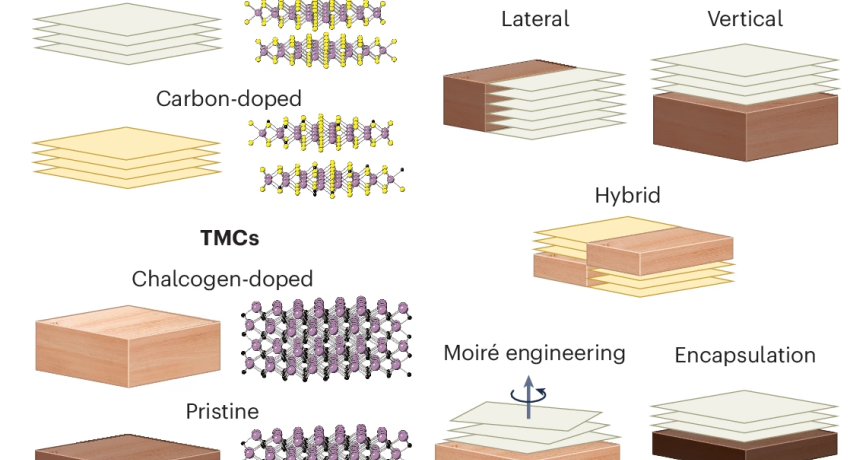Left: we depict non-layered TMCs as wood blocks (bottom) and TMDs as stacks of paper sheets (top), along with representative crystal structures of TMDs (2H-MoS2) and TMCs (β-Mo2C, space group P63/mmc) (right). We have also included ‘stained’ wood and paper to represent chalcogen- and carbon-doped TMCs and TMDs, respectively, along with their atomic structures. Right: representative TMC/TMD heterostructure schematics grouped by the interface formed in the structure. Credit: Terrones/Sinnott
By Jamie Oberdick
Transition metal carbides (TMCs) and transition metal dichalcogenides (TMDs) are emerging as key players with transformative potential across various industries. Originally recognized for their industrial applications like solid-state lubrication, these materials are now the focus of cutting-edge research aimed at revolutionizing electronic devices and catalytic processes.
The growing interest in TMCs and TMDs by researchers, the exotic properties that make them so interesting, and their potential applications to come were discussed in a perspective paper published in Nature Materials by an international team of researchers.
TMDs, such as molybdenum disulfide, are structured in thin layers of metal atoms sandwiched between chalcogen atoms like sulfur. Traditionally used in lubricants, these materials have gained prominence for their electronic properties. Conversely, TMCs, like molybdenum carbide, although more akin to solid rocks than layered materials, exhibit intriguing properties such as superconductivity.
"TMDs like molybdenum disulfide have been used for many years as solid-state lubricants,” said Susan Sinnott, Penn State professor and head of the Department of Materials Science and Engineering and co-corresponding author of the paper. “Recently, we have been interested in their electronic properties. On the other hand, molybdenum carbides, while not layered like TMDs, have fascinating phases, some of which are superconducting."
Materials researchers are pioneering the creation of heterostructures built with TMCs and TMDs. In this context, heterostructures refer to precisely layered combinations of TMCs and TMDs designed to synergistically enhance their properties. This approach aims to engineer materials with unique properties that offer practical benefits across multiple sectors beyond what individual materials offer.
"We can start with a template of a transition metal carbide and convert it into a chalcogenide by introducing sulfur or selenium,” said Mauricio Terrones, Evan Pugh University Professor and professor of physics, professor of chemistry and of material science and engineering, George A. and Margaret M. Downsbrough Head of the Department of Physics at Penn State and co-corresponding author of the study. “Alternatively, we can start with TMDs and introduce carbon to transform them into carbides. These methods allow us to create materials with tailored properties."
By carefully stacking layers of TMCs and TMDs in a specific order, researchers create a sandwich-like structure. This layering allows the combined material to exhibit new and improved properties that neither the TMCs nor the TMDs have on their own. For instance, these heterostructures can conduct electricity more efficiently, enhance electronic devices, or improve certain chemical reactions, leading to new possibilities for applications in technology and industry.
Among potential applications are electronics that are not only smaller and faster, but also more energy-efficient advanced catalysts derived from these materials that could revolutionize clean energy production and environmental remediation efforts.
“We believe our approach could lead to new, smaller, faster, and more sustainable electronic devices, as well as diverse applications in catalysis,” Sinnott said. “Many industrial and automotive chemical reactions are enhanced by catalysis.”
Terrones noted that multiple industries use catalysis to split water molecules for hydrogen and oxygen and would welcome an improved, lower-cost catalysis method. These include energy and fuel, chemical manufacturing, petroleum refining, steel manufacturing, and the food industry.
"Splitting the water molecule to separate hydrogen from oxygen could become more efficient with these materials,” Terrones said. “You could do without using very much energy."
Furthermore, these innovations hold promise for applications in emerging technologies like quantum computing, where precise material properties are critical.
“I think that there are many additional potential applications that we can't even imagine right now,” Sinnott said. “Being able to control material synthesis on these very small, confined layers could contribute to quantum computers, or quantum communication devices that are just now being imagined and developed. They're going to need very precise, very well controlled material systems with ability to tune properties.”
Sinnott added that the work covered in the perspective paper is pointing to some interesting new directions for materials research.
“I think that is where the benefit to society is, forging these beneficial new directions in the research,” Sinnott said. “First you need to develop the materials, and then once you have the materials and tuned their properties, from there you can build out all kinds of applications.”

